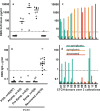N-protein presents early in blood, dried blood and saliva during asymptomatic and symptomatic SARS-CoV-2 infection
- PMID: 33771993
- PMCID: PMC7997897
- DOI: 10.1038/s41467-021-22072-9
N-protein presents early in blood, dried blood and saliva during asymptomatic and symptomatic SARS-CoV-2 infection
Abstract
The COVID-19 pandemic continues to have an unprecedented impact on societies and economies worldwide. There remains an ongoing need for high-performance SARS-CoV-2 tests which may be broadly deployed for infection monitoring. Here we report a highly sensitive single molecule array (Simoa) immunoassay in development for detection of SARS-CoV-2 nucleocapsid protein (N-protein) in venous and capillary blood and saliva. In all matrices in the studies conducted to date we observe >98% negative percent agreement and >90% positive percent agreement with molecular testing for days 1-7 in symptomatic, asymptomatic, and pre-symptomatic PCR+ individuals. N-protein load decreases as anti-SARS-CoV-2 spike-IgG increases, and N-protein levels correlate with RT-PCR Ct-values in saliva, and between matched saliva and capillary blood samples. This Simoa SARS-CoV-2 N-protein assay effectively detects SARS-CoV-2 infection via measurement of antigen levels in blood or saliva, using non-invasive, swab-independent collection methods, offering potential for at home and point of care sample collection.
Conflict of interest statement
D.S., J.M.J., S.C.F., H.S., S.H., D.W., M.M., M.H., E.M.B., K.B., Y.Z., M.C., S.X., X.Y., D.H.W., L.C., K.H., D.M., and A.J.B. work at Quanterix Corporation. P.P.P. and T.P. previously worked at Quanterix Corporation. The remaining authors declare no competing interests.
Figures




References
-
- Roser, M. Ritchie, H., Ortiz-Ospina, E. & Hasell, J. Coronavirus pandemic (COVID-19). https://ourworldindata.org/coronavirus (2020).
Publication types
MeSH terms
Substances
Grants and funding
LinkOut - more resources
Full Text Sources
Other Literature Sources
Medical
Miscellaneous

